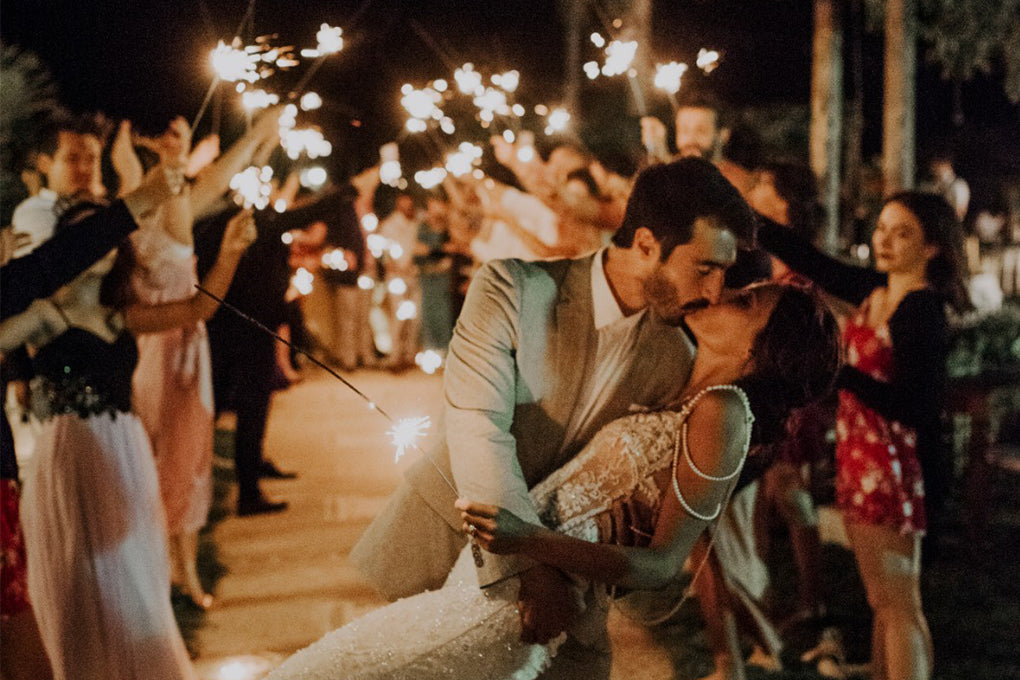
The Odd Origins Behind Your Favorite Wedding Traditions
Written By Annaelle Beenstock
December 24, 2019
While some of them, like exchanging vows, make complete sense, others such as tossing rice on the couple or why gowns are white are slightly more ambiguous.
Whether you’re planning a day filled with traditions and rituals or are going the modern route and keeping it simple, it’s always fun to understand the history of why we do what we do. You’ll be surprised to learn that many of these traditions date back to ancient Rome and have evolved to mean something quite different than what they originally were intended for. Ahead, learn about the origins behind some of our favorite wedding traditions to decide if you’ll include them on your big day.

Bridesmaids
The role of a maid of honor and bridesmaids is often an integral part of the experience. Asking your closest friends to participate in your wedding in such a significant way can make the entire ordeal all the more sentimental. However, the history of why there are bridesmaids in the first place comes from slightly spooky origins. Supposedly, this tradition dates back to ancient Rome when several women would be instructed to dress similarly to the bride to confuse and subsequently ward off evil spirits. Think of it as a really stylish approach to body doubles.
Tossing the Bouquet
Everyone knows that catching the bride’s bouquet is meant to signify you’re the next to be married—but why? Apparently, women used to try to rip pieces of the bride’s wedding gown to steal some of her good luck. Because of this, the bride would throw her bouquet to distract and get away, dress intact.
Throwing Birdseed
Throwing birdseed at the wedding couple as they leave is a tradition that once again goes back to ancient Rome. Rice symbolized fertility and good fortune and tossing it at the two meant they wished financial wealth and a family for them. Now, rice is often swapped for items like bubbles or confetti but the sentiment remains the same.

Something Old, Something New, Something Borrowed, Something Blue
This tradition derives from an Old English rhyme “Something Olde, Something New, Something Borrowed, Something Blue, A Sixpence in your Shoe.” Something old is meant to ward off the Evil Eye. Something new is intended to secure your bright future. Something borrowed brings good luck. And something blue simultaneously wards off the Evil Eye (again) and symbolizes purity, fidelity, and love. If for anything else, it’s fun to come up with your “something” leading up to the big day.
Wedding Cakes
There are several traditions that surround wedding cakes. Saving the top tier to eat on your anniversary and when your first child is born, cutting the cake together on your wedding day, and feeding each other cake (though the latter seems to have decreased in popularity). Ancient Roman grooms used to break a loaf of barley bread over the bride’s head to symbolize fertility. As interesting a tradition as this one is, we’re glad it’s evolved into a less messy version that involves much fewer crumbs.
Placement of Wedding Ring
If you’ve ever wondered why wedding rings are on the fourth finger of the left hand, it’s supposedly because ancient Romans believed that finger’s vein ran directly to the heart. While this may be factually untrue, Vena Amoris (or, “vein of love”) is still a common trope in wedding culture.

Groom Carrying the Bride Over the Threshold
And yet another tradition linked to evil spirits. While this one is less common now, it used to be the norm for a groom to carry his bride over the threshold of their new home. Though this is done more for ceremonial, playful purposes, it’s history goes back to ancient times when Romans believed bad spirits lurked under the entrance to the home. To avoid these spirits touching the soles of the bride’s feet, the groom would carry her over.
White Wedding Dress
White gowns and brides are inextricably linked but it hasn’t always been this way. In fact, it used to be commonplace to wear the nicest item in your closet on your wedding day, regardless of what color it was. However, when Queen Victoria and Prince Albert wed in 1840, she wore a white gown and it’s been considered tradition ever since. Apparently, she chose white because it accentuated the delicacy of her lace. Her bridesmaids also wore white but no other guests did, which solidified the hue as the bridal color du jour for decades to come.